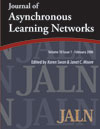MODEL-DRIVEN DESIGN: SYSTEMATICALLY BUILDING INTEGRATED BLENDED LEARNING EXPERIENCES
DOI:
https://doi.org/10.24059/olj.v14i1.1637Keywords:
Model-driven design, blended learning, systems thinkingAbstract
Developing and delivering curricula that are integrated and that use blended learning techniques requires a highly orchestrated design.
While institutions have demonstrated the ability to design complex curricula on an ad-hoc basis, these projects are generally successful at a great human and capital cost.
Model-driven design provides a sustainable approach that reduces some of the cost of complex curriculum development and improves the sustainability of curriculum innovation.
Systems thinking is a perspective for going beyond events, to looking for patterns of behavior, and to seeking underlying systemic interrelationships which are responsible for the patterns of behavior and the events.
Model-driven design provides the ability to share models and learning units beyond the borders of the institution.
References
Gene Bellinger http://www.outsights.com/systems/systhink/systhink.htm
McConnell, S. Rapid Development: Taming Wild Software Schedules. Redmond, WA: Microsoft Press, 1996.
Babson College Web Site http://www3.babson.edu/UG/academics/intermediate-program.cfm
Downloads
Published
Issue
Section
License
As a condition of publication, the author agrees to apply the Creative Commons – Attribution International 4.0 (CC-BY) License to OLJ articles. See: https://creativecommons.org/licenses/by/4.0/.
This licence allows anyone to reproduce OLJ articles at no cost and without further permission as long as they attribute the author and the journal. This permission includes printing, sharing and other forms of distribution.
Author(s) hold copyright in their work, and retain publishing rights without restrictions






